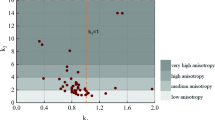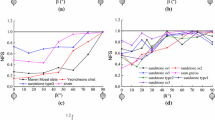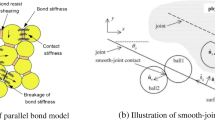Abstract
A new numerical approach based on the particle discrete element method (PDEM) is developed to investigate the mechanical behavior of transversely isotropic rocks with non-continuous planar fabrics. In this numerical model, micro-cracks and interactions between grains are represented as flat joint contact, and the contacts with certain dipping angles are assigned as smooth joint contacts to simulate the non-continuous fabrics. The following are studied using the numerical model: (1) the effects of the micro-structure of the rock matrix and the fabric micro-parameters on the tensile and shear strength and the fracture patterns of rocks under Brazilian tests, and (2) the model calibration process for determining the micro-parameters and the failure process of rocks influenced by the micro-structure of the rock matrix. The results show that: (1) based on the Brazilian test results of 20 kinds of transversely isotropic rocks with non-continuous planar fabrics, six patterns regarding the relationship between the normalized failure strength (NFS) and fabric-loading angles are obtained; and (2) the patterns of the NFS curves are slightly affected by the contact state of particles in the rock matrix, while greatly affected by the amount of preexisting micro-cracks in rock matrix, and the stiffness, strength and distributed region of the fabrics; (3) the calibrated results of six typical rocks with different patterns agreed well with the experimental results with regards to failure strength and fracture patterns; and (4) during the failure process, micro-cracks the in rock matrix are mainly formed as the tensile and shear breakage of preexisting cracks, and micro-cracks on fabrics appear mostly at the aggregated region of preexisting cracks.























Similar content being viewed by others
References
Abousleiman YN, Hoang SK, Liu C (2014) Anisotropic porothermoelastic solution and hydro-thermal effects on fracture width in hydraulic fracturing. Int J Numer Anal Methods Geomech 38:493–517
Ai C, Zhang J, Li YW et al (2015) Theoretical calculation and experimental research on tensile strength of coal rock under different splitting angles. Saf Coal Mines 46:20–23
Amadei B (1996) Importance of anisotropy when estimating and measuring in situ stresses in rock. Int J Rock Mech Min Sci Geomech Abstr 33:293–325
Ambrose J, Zimmerman RW, Suarez R (2014) Failure of shales under triaxial compressive stress. In: The 48th US rock mechanics/geomechanics symposium, Minneapolis
Bahaaddini M, Sharrock G, Hebblewhite BK (2013) Numerical direct shear tests to model the shear behaviour of rock joints. Comput Geotech 51:101–115
Beyhan S, Özgür A (2015) Investigating the anisotropy of rocks depending on the indirect tensile strength. In: EUROCK 2015 and 64th geomechanics colloquium, Salzburg
Chen PY (2017) Effects of microparameters on macroparameters of flat-jointed bonded particle materials and suggestions on trial-and-error method. Geotech Geol Eng 35:1–15
Chen CS, Pan E, Amadei B (1998) Determination of deformability and tensile strength of anisotropic rock using Brazilian tests. Int J Rock Mech Min Sci 35:43–61
Chen YF, Wei K, Liu W et al (2016) Experimental characterization and micromechanical modelling of anisotropic slates. Rock Mech Rock Eng 49:3541–3557
Cheng Y, Wong LNY, Zou C (2015) Experimental study on the formation of faults from en-echelon fractures in Carrara Marble. Eng Geol 195:312–326
Cho JW, Kim H, Jeon SK, Min KB (2012) Deformation and strength anisotropy of Asan gneiss, Boryeong shale, and Yeoncheon schist. Int J Rock Mech Min Sci 50:158–169
Chong ZH, Li XH, Hou P et al (2017) Numerical investigation of bedding plane parameters of transversely isotropic shale. Rock Mech Rock Eng 50:1183–1204
Dan DQ (2011) Brazilian test on anisotropic rocks: laboratory experiment, numerical simulation and interpretation. Dissertation, Freiberg University of Technology
Dan DQ, Konietzky H (2014) Numerical simulations and interpretations of Brazilian tensile tests on transversely isotropic rocks. Int J Rock Mech Min Sci 71:53–63
Debecker B (2009) Influence of planar heterogeneities on the fracture behavior of rock. Katholieke Universiteit Leuven, Leuven
Dewhurst DN, Siggins AF (2006) Impact of fabric, microcracks and stress field on shale anisotropy. Geophys J Int 65:135–148
Duan K, Kwok CY (2015) Discrete element modeling of anisotropic rock under Brazilian test conditions. Int J Rock Mech Min Sci 78:46–56
Duan K, Kwok C, Wu W, Lu J (2018) DEM modeling of hydraulic fracturing in permeable rock: influence of viscosity, injection rate and in situ states. Acta Geotech 13:1187–1202
Everitt RA, Lajtai EZ (2014) The influence of rock fabric on excavation damage in the Lac du Bonnett granite. Int J Rock Mech Min Sci 41:1277–1303
Ghazvinian E, Diederichs MS, Quey R (2014) 3D random Voronoi grain-based models for simulation of brittle rock damage and fabric-guided micro-fracturing. J Rock Mech Geot Eng 6:506–521
Gholamreza K, Behruz R, Yasin A (2015) An experimental investigation of the Brazilian tensile strength and failure patterns of laminated sandstones. Rock Mech Rock Eng 48:843–852
Gong QM, Zhao J, Jiao YY (2005) Numerical modeling of the effects of joint orientation on rock fragmentation by TBM cutters. Tunn Undergr Sp Technol 20:183–191
Hakala M, Kuula H, Hudson JA (2007) Rock properties for in situ stress measurement data reduction: a case study of the Olkiluoto mica gneiss, Finland. Int J Rock Mech Min Sci 44:14–46
Hornby BE, Schwartz LM, Hudson JA (1994) Anisotropic effective-medium modelling of the elastic properties of shales. Geophysics 59:1570–1583
Hou P, Gao F, Yang YG et al (2016) Effect of layer orientation on the failure of block shale under Brazilian splitting test and energy analysis. Chin J Geotech Eng 38:930–937
Imani M, Nejati HR, Goshtasbi K (2017) Dynamic response and failure mechanism of Brazilian disk specimens at high strain rate. Soil Dyn Earthq Eng 100(Supplement C):261–269
Itasca Consulting Group Inc. (2008) Particle flow code in 2 dimensions user’s guide, Minneapolis
Jia P, Tang CA (2008) Numerical study on failure mechanism of tunnel in jointed rock mass. Tunn Undergr Sp Technol 23:500–507
Kaufhold A, Gräsle W, Plischke I et al (2013) Influence of carbonate content and micro fabrics on the failure strength of the sandy facies of the Opalinus Clay from Mont Terri (Underground Rock Laboratory). Eng Geol 156:111–118
Khanlari GR, Heidari M, Sepahigero AA et al (2014) Quantification of strength anisotropy of metamorphic rocks of the Hamedan province, Iran, as determined from cylindrical punch, point load and Brazilian tests. Eng Geol 169:80–90
Kim H, Cho JW, Song I et al (2012) Anisotropy of elastic moduli, P-wave velocities, and thermal conductivities of Asan Gneiss, Boryeong Shale, and Yeoncheon Schist in Korea. Eng Geol 148:68–77
Kim KY, Zhuang L, Yang H et al (2016) Strength anisotropy of Berea sandstone: results of X-Ray computed tomography, compression tests, and discrete modeling. Rock Mech Rock Eng 49:1201–1210
Koyama T, Jin LR (2007) Effects of model scale and particle size on micro-mechanical properties and failure processes of rocks—a particle mechanics approach. Eng Anal Bound Elem 31(5):458–472
Kumar N, Luding S, Magnanimo V (2014) Macroscopic model with anisotropy based on micro–macro information. Acta Geotech 225:2319–2343
Kundu J, Mahanta B, Sarkar K et al (2018) The effect of lineation on anisotropy in dry and saturated Himalayan schistose rock under Brazilian test conditions. Rock Mech Rock Eng 51:5–21
Li ZG, Xu GL, Huang P et al (2018) Mechanical and anisotropic properties of silty slates. Rock Soil Mech 39:1737–1746
Li KH, Cheng YM, Fan X (2018) Roles of model size and particle size distribution on macro-mechanical properties of Lac du Bonnet granite using flat-joint model. Comput Geotech 103:43–60
Lisjak A, Grasselli G, Vietor T (2014) Continuum–discontinuum analysis of failure mechanisms around unsupported circular excavations in anisotropic clay shales. Int J Rock Mech Min Sci 65:96–115
Lisjak A, Garitte B, Grasselli G et al (2015) The excavation of a circular tunnel in a bedded argillaceous rock (Opalinus Clay): short-term rock mass response and FDEM numerical analysis. Tunn Undergr Sp Technol 45:227–248
Liu YS (2013) Brazilian splitting test theory and engineering application for transversely isotropic rock. Dissertation, Central South University
Liu SL, Chen SX, Yu F et al (2012) Anisotropic properties study of chlorite schist. Rock Soil Mech 33:3616–3623
Liu J, Wang L, Li JL (2017) Experimental study on transverse isotropy strength parameter of quartz–mica schist. Chin J Rock Mech Eng 36:3740–3751
Mehranpour MH, Kulatilake PHSW (2017) Improvements for the smooth joint contact model of the particle flow code and its applications. Comput Geotech 87:163–177
Mighani S, Sondergeld C, Rai C (2014) Efficient completions in anisotropic shale gas formations. In: Proceedings of the unconventional resources technology conference (URTeC), 25–27 August 2014. URTeC 1934272, Denver
Mokhtari M (2015) Characterization of anisotropy in organic-rich shales: shear and tensile failure, wave velocity, matrix and fracture permeability. Dissertation, Colorado School of Mines
Ozcelik Y, Yilmazkaya E (2011) The effect of the rock anisotropy on the efficiency of diamond wire cutting machines. Int J Rock Mech Min Sci 48:626–636
Parés JM, Miguens L, Saiz C (2016) Characterizing pore fabric in sandstones with magnetic anisotropy methods: initial results. J Pet Sci Eng 143:113–120
Park B, Min KB (2015) Bonded-particle discrete element modeling of mechanical behavior of transversely isotropic rock. Int J Rock Mech Min Sci 76:243–255
Popp T, Salzer K, Minkley W (2008) Influence of bedding planes to EDZ-evolution and the coupled HM properties of Opalinus Clay. Phys Chem Earth 33:374–387
Potyondy DO (2012) PFC 2D flat joint contact model. Itasca Consulting Group Inc., Minneapolis
Potyondy D (2017) Simulating perforation damage with a flat-jointed bonded-particle material. In: 51st US rock mechanics/geomechanics symposium. American Rock Mechanics Association
Potyondy DO, Cundall PA (2004) A bonded-particle model for rock. Int J Rock Mech Min Sci 41(8):1329–1364
Ramamurthy T (1993) Strength and modulus responses of anisotropic rocks. In: Hudson JA (ed) Comprehensive rock engineering. Pergamon Press, Oxford, pp 313–329
Roy DG, Singh TN (2016) Effect of heat treatment and layer orientation on the tensile strength of a crystalline rock under Brazilian test condition. Rock Mech Rock Eng 49:1–15
Saeidi O, Vaneghi RG, Rasouli V et al (2014) A modified failure criterion for transversely isotropic rocks. Geosci Front 5(2):215–225
Simpson NDJ (2013) An analysis of tensile strength, fracture initiation and propagation in anisotropic rock (gas shale) using Brazilian tests equipped with high speed video and acoustic emission. Dissertation, Norwegian University of Science and Technology
Song I, Suh M (2014) Effects of foliation and microcracks on ultrasonic anisotropy in retrograde ultramafic and metamorphic rocks at shallow depths. J Appl Geophys 109:27–35
Svitelman V, Dinariev O (2013) Geostatistical approach to the anisotropy analysis of 3D rock microtomographic models. Comput Geosci 57:116–123
Tan X, Konietzky H, Fruhwirt T et al (2015) Brazilian tests on transversely isotropic rocks: laboratory testing and numerical simulations. Rock Mech Rock Eng 48:1341–1351
Tavallali A, Vervoort A (2010) Effect of layer orientation on the failure of layered sandstone under Brazilian test conditions. Int J Rock Mech Min Sci 47:313–322
Vervoort A, Min KB, Konietzky H et al (2014) Failure of transversely isotropic rock under Brazilian test conditions. Int J Rock Mech Min Sci 70:343–352
Wang PT, Cai MF, Ren FH (2018) Anisotropy and directionality of tensile behaviours of a jointed rock mass subjected to numerical Brazilian tests. Tunn Undergr Sp Technol 73:139–153
Wu SC, Xu XL (2016) A study of three intrinsic problems of the classic discrete element method using flat-joint model. Rock Mech Rock Eng 49(5):1813–1830
Wu HR, Zhao JD, Guo N (2018) Multiscale insights into borehole instabilities in high-porosity sandstones. J Geophys Res Solid Earth 123(5):3450–3473
Wu H, Guo N, Zhao J (2018) Multiscale modeling and analysis of compaction bands in high-porosity sandstones. Acta Geotech 13(3):575–599
Xia L, Zeng Y (2018) Parametric study of smooth joint parameters on the mechanical behavior of transversely isotropic rocks and research on calibration method. Comput Geotech 98:1–7
Xu GW, He C, Su A et al (2018) Experimental investigation of the anisotropic mechanical behavior of phyllite under triaxial compression. Int J Rock Mech Min Sci 104:100–112
Xu G, He C, Chen ZQ et al (2018) Transverse isotropy of phyllite under Brazilian tests: laboratory testing and numerical simulations. Rock Mech Rock Eng 51:1111–1135
Xu G, He C, Chen Z, Wu D (2018) Effects of the micro-structure and micro-parameters on the mechanical behaviour of transversely isotropic rock in Brazilian tests. Acta Geotech 13:887–910
Yang ZP, He B, Xie LZ et al (2015) Strength and failure modes of shale based on Brazilian test. Rock Soil Mech 36:3447–3464
Yao GH, Chen Q, Liu H et al (2015) Experiment study on mechanical properties of bedding shale in lower Silurian Longmaxi shale southeast Chongqing. Chin J Rock Mech Eng 34:3313–3319
Zeng QD, Yao J, Shao JF (2018) Numerical study of hydraulic fracture propagation accounting for rock anisotropy. J Pet Sci Eng 160:422–432
Zhang Q (2013) Modification of generalized 3D Hooke–Brown rock masses strength criterion and its parameters multi-scale studies. Ph.D. dissertation, Tongji University, Shanghai
Zhang Y, Stead D, Elmo D (2015) Characterization of strength and damage of hard rock pillars using a synthetic rock mass method. Comput Geotech 65:56–72
Zhang SW, Shou KJ, Xian XF et al (2018) Fractal characteristics and acoustic emission of anisotropic shale in Brazilian tests. Tunn Undergr Sp Tech 71:298–308
Zhao JD, Jiang MJ, Soga K, Luding S (2016) Micro origins for macro behavior in granular media. Granul Matter 18:59
Acknowledgements
This research was supported by the U.S. Department of Transportation (DOT) under Grant No. 69A3551747118 and National key research and development program of China (Grant No. 2016YFC08022010). The opinions expressed in this paper are those of the Authors and not of the sponsors.
Author information
Authors and Affiliations
Corresponding author
Ethics declarations
Conflict of interest
The authors declare that they have no conflicts of interest.
Additional information
Publisher's Note
Springer Nature remains neutral with regard to jurisdictional claims in published maps and institutional affiliations.
Rights and permissions
About this article
Cite this article
Xu, G., Gutierrez, M., He, C. et al. Discrete element modeling of transversely isotropic rocks with non-continuous planar fabrics under Brazilian test. Acta Geotech. 15, 2277–2304 (2020). https://doi.org/10.1007/s11440-020-00919-7
Received:
Accepted:
Published:
Issue Date:
DOI: https://doi.org/10.1007/s11440-020-00919-7




